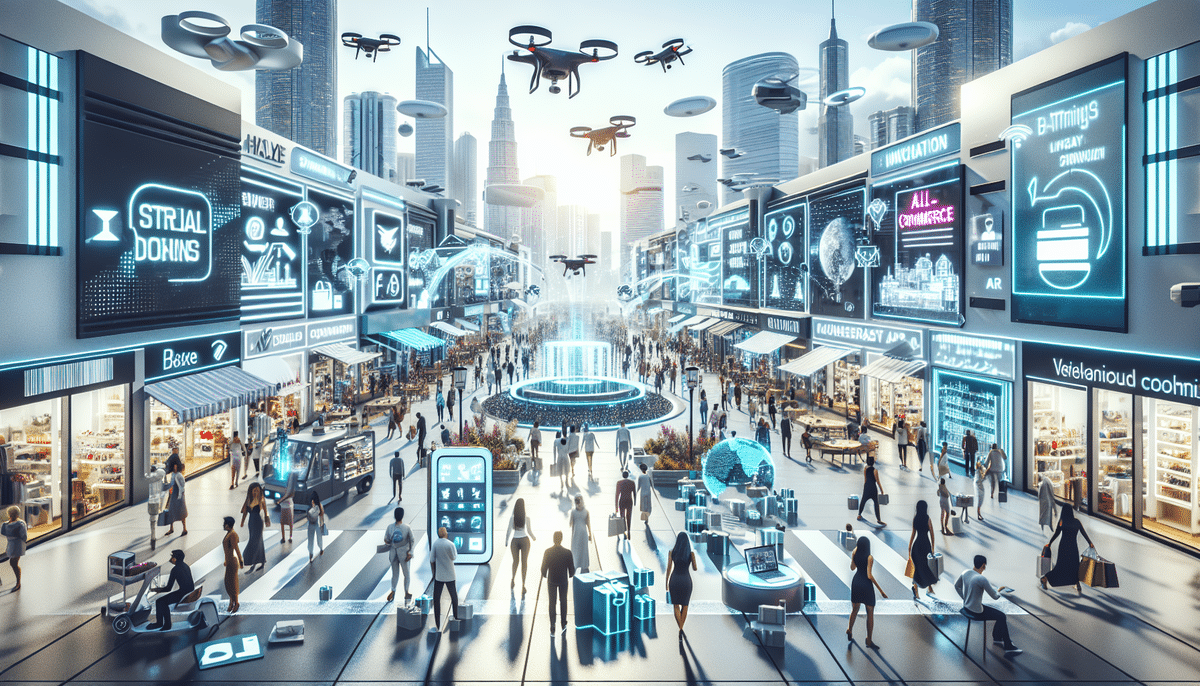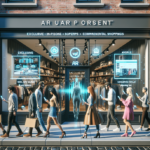Emerging E-Commerce Trends
The retail industry is undergoing a significant transformation, driven by the integration of various channels into a unified all-in-commerce experience. This approach benefits both consumers and businesses by providing seamless interactions across multiple platforms. Below, we explore the latest trends shaping the e-commerce landscape.
The Rise of E-Commerce
E-commerce continues to be a dominant force in retail. The convenience of online shopping has led to substantial growth, with eMarketer reporting that global e-commerce sales reached approximately $6.3 trillion in 2023, projected to exceed $7.4 trillion by 2025. This surge has compelled retailers to prioritize online channels to meet consumer demand.
However, the expansion of e-commerce has resulted in the closure of numerous physical stores. To stay competitive, retailers must innovate and swiftly adapt to emerging trends and technologies.
One key advantage of e-commerce is the ability to personalize the shopping experience using data analytics and machine learning. By tracking customer behavior and preferences, retailers can offer tailored recommendations and promotions, enhancing customer satisfaction and boosting sales.
Additionally, the rise of social commerce has transformed platforms like Instagram and Facebook into direct sales channels, enabling businesses to reach broader audiences without the need for separate e-commerce websites.
Direct-to-Consumer (DTC) Brands
Direct-to-consumer (DTC) brands are revolutionizing the retail space by eliminating traditional middlemen and selling directly to customers. This model often results in lower costs and allows for greater control over branding and customer relationships. DTC brands leverage personalization technologies to deliver customized services, fostering strong customer loyalty.
Subscription-Based Models
Subscription-based models are gaining traction, offering customers regular deliveries of curated products tailored to their preferences. This approach emphasizes personalization and convenience, aligning with modern consumer expectations for tailored shopping experiences.
Enhancing Customer Experience through Personalization
Personalization is at the core of modern retail strategies, driving customer loyalty and increasing conversion rates. By utilizing advanced technologies, retailers can create highly customized shopping experiences that resonate with individual consumers.
Data-Driven Personalization
Retailers employ data-driven algorithms to analyze customer behavior, enabling the delivery of personalized recommendations and deals. This not only enhances the shopping experience but also provides valuable insights into consumer preferences, guiding inventory and marketing decisions.
AI and Machine Learning
Artificial intelligence (AI) and machine learning are pivotal in personalizing the shopping journey. AI-powered chatbots offer personalized assistance, guiding customers through their purchases and addressing queries efficiently. Machine learning algorithms analyze vast datasets to identify consumer trends, optimize pricing strategies, and enhance overall operational efficiency.
Big Data Analytics
Big data analytics allows retailers to understand customer behavior comprehensively. By analyzing data from various touchpoints, retailers can make informed decisions about product offerings, marketing campaigns, and inventory management, ensuring they meet evolving customer needs effectively.
Technological Innovations Driving Retail
Technological advancements are reshaping the retail landscape, enabling more immersive and efficient shopping experiences.
Mobile-First Strategies
With the increasing use of mobile devices for shopping, retailers are adopting mobile-first strategies. This includes responsive website designs and dedicated mobile apps to ensure a seamless shopping experience on smartphones and tablets.
Moreover, technologies like augmented reality (AR) and virtual reality (VR) are being integrated into mobile platforms, allowing customers to virtually try on products or visualize items in their own spaces before making a purchase.
Payment Processing Innovations
Innovations in payment processing are enhancing the convenience and security of online transactions. Key developments include:
- Digital Wallets: Services like Apple Pay and Google Wallet offer quick and secure payment options.
- Peer-to-Peer Payments: Platforms such as PayPal and Venmo facilitate easy money transfers between individuals.
- Contactless Payments: Increasingly popular, especially post-pandemic, allowing for swift and hygienic transactions.
Emerging Technologies
Several emerging technologies are set to further transform retail:
- Blockchain: Enhances transparency and security in transactions and supply chain management.
- 5G: Enables faster internet speeds, supporting more sophisticated mobile shopping experiences.
- Internet of Things (IoT): Facilitates smarter inventory management and personalized customer interactions.
- Augmented Reality (AR): Provides interactive and immersive shopping experiences.
Effective Marketing and Omnichannel Strategies
Successful retailers leverage diverse marketing strategies and omnichannel approaches to reach and engage customers across multiple platforms.
Social Media Impact
Social media platforms play a crucial role in driving retail sales. They enable retailers to connect with target audiences, build brand awareness, and execute viral marketing campaigns. User-generated content on platforms like Instagram and Facebook fosters brand advocacy and enhances customer engagement.
Moreover, social media analytics provide insights into customer preferences and behaviors, allowing retailers to tailor their marketing efforts effectively.
Influencer Marketing
Influencers have become integral to e-commerce marketing strategies. Their large and engaged audiences can significantly impact purchase decisions. By partnering with influencers, retailers can promote their products authentically and reach specific demographics, enhancing brand visibility and credibility.
Omnichannel Strategy Best Practices
An effective omnichannel strategy ensures a consistent and seamless shopping experience across all channels, including physical stores, online platforms, and mobile devices. Key best practices include:
- Investing in responsive design to maintain a uniform user experience across different devices.
- Utilizing data analytics to personalize customer interactions and recommendations.
- Ensuring a consistent brand message and visual identity across all channels.
Operational Excellence and Security
Optimizing operations and ensuring security are fundamental to sustaining growth in all-in-commerce.
Inventory Management
Managing inventory across multiple channels poses significant challenges. Retailers can overcome these by:
- Investing in integrated inventory management tools that sync across all sales channels.
- Implementing real-time inventory tracking to prevent stockouts and overstock situations.
- Maintaining an agile supply chain that can swiftly respond to changes in customer demand.
Cross-Border E-Commerce
Expanding into international markets involves navigating complex logistics, diverse regulations, and cultural differences. Successful cross-border e-commerce strategies include:
- Automating fulfillment processes to streamline international shipping.
- Offering localized payment options to cater to different markets.
- Ensuring legal compliance with local laws and regulations.
Security Concerns
Protecting customer data and securing online transactions are paramount. Retailers must:
- Invest in secure payment processing technologies to safeguard financial information.
- Use encryption for data storage and transmission to protect sensitive information.
- Conduct regular security audits to identify and address potential vulnerabilities.
Staying Competitive in a Dynamic Market
To remain competitive in the rapidly evolving all-in-commerce industry, retailers must be proactive and adaptable. Key strategies include:
- Keeping abreast of the latest trends and technological advancements.
- Investing in personalization and omnichannel strategies to enhance customer experiences.
- Focusing on delivering high-quality customer service to build loyalty and trust.
By continuously evolving and prioritizing customer needs, retailers can thrive in a highly competitive and ever-changing market landscape.
Conclusion
All-in-commerce represents a dynamic and integrative approach to retail, encompassing the latest trends and technologies to create a seamless shopping experience. Key trends shaping this landscape include the rise of e-commerce, personalization through AI and big data, technological innovations like AR and blockchain, effective marketing strategies, and operational excellence. Retailers that embrace these trends and adapt to changing consumer demands are well-positioned to succeed in the competitive and rapidly evolving retail industry.




















